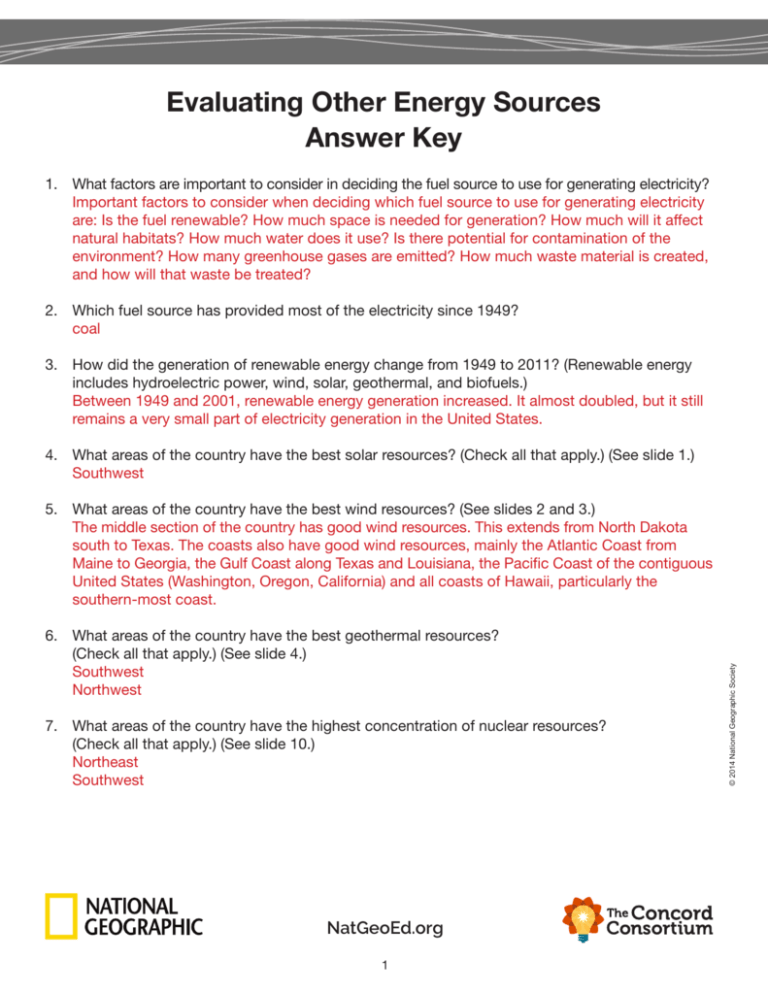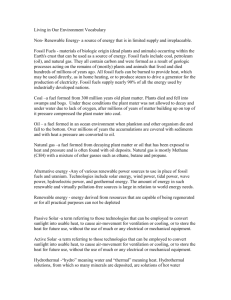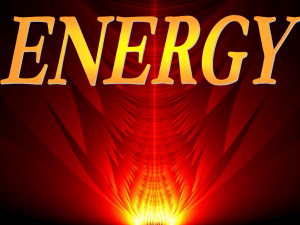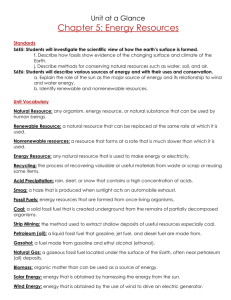Energy Sources Answer Key: Evaluating Electricity Generation
advertisement

Evaluating Other Energy Sources Answer Key 1. What factors are important to consider in deciding the fuel source to use for generating electricity? Important factors to consider when deciding which fuel source to use for generating electricity are: Is the fuel renewable? How much space is needed for generation? How much will it affect natural habitats? How much water does it use? Is there potential for contamination of the environment? How many greenhouse gases are emitted? How much waste material is created, and how will that waste be treated? 2. Which fuel source has provided most of the electricity since 1949? coal 3. How did the generation of renewable energy change from 1949 to 2011? (Renewable energy includes hydroelectric power, wind, solar, geothermal, and biofuels.) Between 1949 and 2001, renewable energy generation increased. It almost doubled, but it still remains a very small part of electricity generation in the United States. 4. What areas of the country have the best solar resources? (Check all that apply.) (See slide 1.) Southwest 6. What areas of the country have the best geothermal resources? (Check all that apply.) (See slide 4.) Southwest Northwest 7. What areas of the country have the highest concentration of nuclear resources? (Check all that apply.) (See slide 10.) Northeast Southwest NatGeoEd.org 1 © 2014 National Geographic Society 5. What areas of the country have the best wind resources? (See slides 2 and 3.) The middle section of the country has good wind resources. This extends from North Dakota south to Texas. The coasts also have good wind resources, mainly the Atlantic Coast from Maine to Georgia, the Gulf Coast along Texas and Louisiana, the Pacific Coast of the contiguous United States (Washington, Oregon, California) and all coasts of Hawaii, particularly the southern-most coast. Evaluating Other Energy Sources Answer Key, continued 8. What areas of the country have the most fossil fuel (natural gas and coal) resources? (See slides 7, 8, and 9.) The most fossil fuels are found in the Northeast, Midwest, Gulf Coast area, and middle section of the country, basically everywhere but Florida and the West Coast. 9. What energy sources are most abundant in your area of the country? Student answers will vary. Check the maps for the resource availability in your location. 10. Which fuel source used to generate electricity emits the most carbon dioxide? coal 11. Which fuel source used to generate electricity emits the most methane? natural gas 12. Earth’s climate system consists of greenhouse gases, incoming solar radiation, and outgoing infrared (heat) radiation. Describe how fossil fuel usage affects Earth’s climate system. Fossil fuel usage increases the amount of carbon dioxide being emitted into the atmosphere. Carbon dioxide is a greenhouse gas. Greenhouse gases trap heat in the atmosphere. Therefore fossil fuel usage leads to increasing temperatures as carbon dioxide traps heat in the atmosphere. 14. Explain your answer. Hydropower doesn’t add any contaminants to the water. The quality of the water may be affected by being dammed up, but it will not be contaminated with heavy metals by being dammed up. Wind and solar may contaminate water supplies just because the manufacturing process uses rare and/or toxic materials. Geothermal probably doesn’t have much of an effect on water quality, unless the pipes in the ground leak into an aquifer. Biomass also probably doesn’t have much of an effect on water quality. Water is used to grow crops for fuel, so it might be contaminated with residues from pesticides, if they were used in growing the crops. Natural gas will only contaminate water if there is a leak, but leaks sometimes happen. Coal can contaminate the water directly with runoff from mines, or it can contaminate the water with particulate emissions after it’s burned. Nuclear also has a low potential for water contamination unless there is a leak, which has not happened in this country but has happened in other areas of the world. NatGeoEd.org 2 © 2014 National Geographic Society 13. Which energy source used to generate electricity has the lowest environmental impact on water quality? hydropower Evaluating Other Energy Sources Answer Key, continued 15. All energy sources have an ecological impact. Why is it important to consider land use when thinking about renewable energy sources? It is important to think about land use, particularly when thinking about renewable energy sources, because renewable energy sources take up a lot of space. Solar farms and wind farms take up vast areas and can cause fragmentation or destruction of natural habitats. 16. Which energy source has the largest ecological impact on its surroundings? hydropower 17. Explain your answer. Hydropower has a large ecological impact on its surroundings. Rivers are dammed up preventing the free migration of fish species up- and downstream. Currents are destroyed by the damming, messing up the cues that migratory fish use to navigate the river. The animals that prey on the fish are affected by the disrupted flow. Sediments aren’t carried downstream, leading to the depletion of river deltas. The land that used to surround the river is put underwater, displacing thousands of acres of natural habitat for organisms. The water is deeper and therefore colder than it would otherwise be. This disrupts the habitats of animals that live in the water. Nuclear has a low impact on the environment aside from issues directly at the mining sites, where runoff can affect local aquifers, and nuclear accidents, which affect the area around the nuclear plant. Nuclear plants also discharge heated water into streams and lakes that can kill fish by depleting the level of oxygen in the water. Geothermal has a very low impact on the ecosystem. There is some disruption as wells are drilled, but unless there are leaks from the wells, there is very low effect on local habitats. Wind and solar both take vast areas of land, which can disrupt local ecosystems. The noise from wind turbines can disrupt animal communications, and animals can fly into the turbines and be hurt or killed. NatGeoEd.org 3 © 2014 National Geographic Society Fossil fuels have a lower impact than hydropower. Extracting the fossil fuels can have a local environmental impact, but those impacts can be managed with careful planning. Burning fossil fuels has an impact on air quality, which can affect ecosystems nearby and far away as the wind moves pollutants through the air. Evaluating Other Energy Sources Answer Key, continued 18. Why is it beneficial to have many different sources for electricity generation, even though some sources are quite inefficient in some respects (as biofuels)? Relying on many different options is better for Earth than relying on a single option for electricity generation. Spreading out the risk over several different sources means that at least one source will be available any time. If you rely on a single source, it can easily be depleted, and then you’re stuck trying to develop new sources while having no electricity in the present. If you have multiple sources, you can develop more environmentally-friendly ways of extracting the fuel as opposed to having to get the fuel in whatever way necessary because it’s the only fuel source. Even an inefficient fuel source is better than using a more efficient fuel source in a way that’s hazardous to local ecosystems. 19. Which energy source used to generate electricity in the United States is most efficient? hydropower 21. How certain are you about your claim based on your explanation? Student answers will vary. 22. Explain what influenced your certainty rating. Student answers will vary. Scientific evidence includes specific reference to numbers in the table. Students may state that they don’t know whether to measure efficiency in terms of MWh per unit land or dollars per MWh. NatGeoEd.org 4 © 2014 National Geographic Society 20. Explain your answer. Hydropower is the most efficient power source. The cost per unit of electricity is the lowest for hydropower (starting at $59 per MWh). The cost is a measure of the efficiency. Once the dam is built and the turbines installed, there is very little cost to generating more electricity. The water does not have to be mined and transported to the plant; it flows there automatically. Measured by energy per square meter, natural gas is the most efficient. There is a lot of natural gas, and it is in the same price range per MWh as hydropower. It just depends on how you measure efficiency.






